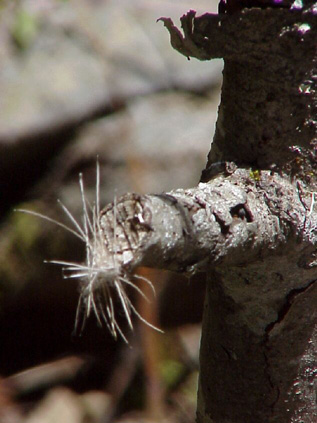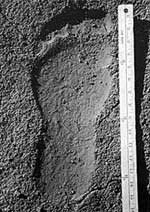
May 25, 2006
Making decisions about what you want and need to bring along on your next cryptid-seeking outing is not just about what you have available to throw in the back of the pick-up anymore. What do you take along and recommend to others? Carrying a good camera, so you can take pictures like this great one by Rick Noll, of hair caught on a broken branch, posted earlier on Cryptomundo, is a no-brainer. But let’s put some thought behind the other things to bring on your excursion, too.

Steven Titchenell, organizer of the WVBIG (West Virginia Bigfoot Investigations Group) Expedition has posted a checklist of items for his group to take on their forthcoming trek in search of unknown hairy hominoids in their area. One can find good lists of forensic materials that should be taken on expeditions throughout the net, and, for example, Rick Noll has lectured on the subject, of course.
Most treks are rather casual and not full of high-end materials that call for a great deal of money to obtain or a lot of technological knowledge to operate. Nevertheless, the days of going off into the wilderness with a notebook, disposable camera, and bag of plaster of Paris are gone.
Titchenell, for instance, ask for additional suggestions regarding his checklist, and has given permission to use his "starter’s list" as a jumping off point for a discussion of the topic here. I thought people might like to ponder what you would want to take on a relatively lightweight (equipment-wise) exploration into the woods. One can begin a discussion anywhere, so there’s no reason not to begin it with Titchenell’s list.
WVBIG Expedition Checklist An expedition party or an individual researcher should have the following equipment on an expedition: 1. Paper sacks & envelopes 2. Camera/video recorder (Preferrably with night vision) 3. Tweezer/tongs 4. Rubber gloves 5. Magnifying glass 6. Parabolic mic 7. Plaster of Paris 8. Tape measure 9. Log book
++++++
Some additional suggestions from me:
Bring a tape/audio recorder to record sounds from that parabolic microphone. Make certain you have brought blank tapes along, so you aren’t scrambling to decide whether it is your self-made Kenny Chesney or AC/DC tape in your truck’s cassette player that you are going to have to record over.
Have a few sterile collecting bottles or containers for fecal material samples and for urine specimens (for example from snow). It is recommended that urine samples not be collected from a live Bigfoot.
For DNA collection, you will want to have sterile latex gloves (make certain they fit you – remember O.J.), and bring along equipment to gather samples properly. If hair sampling envelopes are not available, place samples into small sealed paper envelope or zip lock bag (no brand recommended). Use a permanent marker or pen, clearly include all sampling information with each sample. This includes name of collector, time, date, assumed cryptid, human, or known species name, field tag number, gender (if known), age (if known), location including lat./long., Universal Transverse Mercator (UTM) or township. Hair samples should be kept and shipped dry, so don’t forget to put them in your dry vehicle, if possible, and not under that dripping redwood.
Definitely have a colored (e.g. yellow) rigid one foot ruler or fold-up meter stick for scale in photographs of tracks or other permanent material evidence. Product placement photos, like an empty from your Sierra Nevada Bigfoot Ale collection next to a footprint, are not recommended (even though we know they are exactly 7.5 inches or 20 cm long). Remember these photos may have a life far beyond your own group, so make certain your kid’s "Sesame Street" ruler with Elmo on it is what you really want to have pictured next to that track find of the century you have just discovered.

About Loren Coleman
Loren Coleman is one of the world’s leading cryptozoologists, some say “the” leading living cryptozoologist. Certainly, he is acknowledged as the current living American researcher and writer who has most popularized cryptozoology in the late 20th and early 21st centuries.
Starting his fieldwork and investigations in 1960, after traveling and trekking extensively in pursuit of cryptozoological mysteries, Coleman began writing to share his experiences in 1969. An honorary member of Ivan T. Sanderson’s Society for the Investigation of the Unexplained in the 1970s, Coleman has been bestowed with similar honorary memberships of the North Idaho College Cryptozoology Club in 1983, and in subsequent years, that of the British Columbia Scientific Cryptozoology Club, CryptoSafari International, and other international organizations. He was also a Life Member and Benefactor of the International Society of Cryptozoology (now-defunct).
Loren Coleman’s daily blog, as a member of the Cryptomundo Team, served as an ongoing avenue of communication for the ever-growing body of cryptozoo news from 2005 through 2013. He returned as an infrequent contributor beginning Halloween week of 2015.
Coleman is the founder in 2003, and current director of the International Cryptozoology Museum in Portland, Maine.
Filed under Artifacts, Bigfoot, Cryptotourism, CryptoZoo News, Cryptozoology, Forensic Science